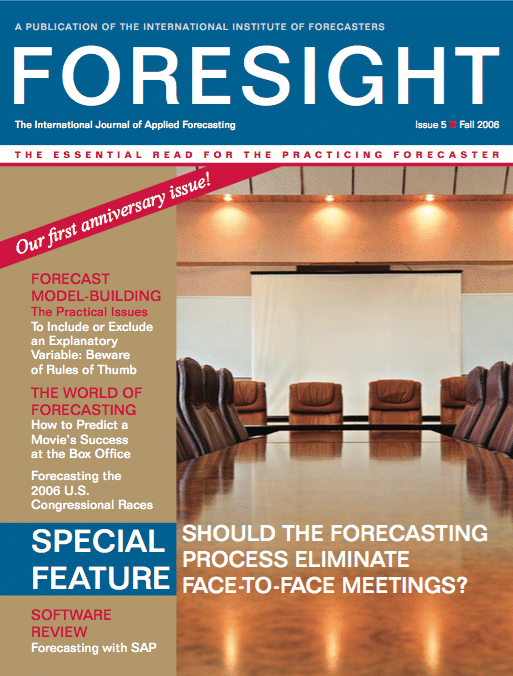FORESIGHT, Issue 5
$45.00
Description
Fall 2006 Issue
Special Feature: Should the Forecasting Process Eliminate Face-to-Face Meetings?
- How to Make Better Forecasts and Decisions: Avoid Face-to-Face Meetings by J. Scott Armstrong
When financial columnist James Surowiecki wrote The Wisdom of Crowds, he wished to explain the successes and failures of markets (an example of a “crowd”) and to understand why the average opinion of a crowd is frequently more accurate than the opinions of most of its individual members. In this expanded review of the book, Scott Armstrong asks a question of immediate relevance to forecasters: Are the traditional face-to-face meetings an effective way to elicit forecasts from forecast crowds (i.e. teams)? Armstrong doesn’t believe so. Quite the contrary, he explains why he considers face-to-face meetings a detriment to good forecasting practice, and he proposes several alternatives that have been tried successfully.- Commentaries
- Forecasting Meetings Are Really Not About Forecasting by Marcus O’Connor
- A Depersonalized Interactive Process is the Key, Joe Smith
- Business Objectives, Forecasters and Meetings by Jamilya Kasymova and Catalin Vieru
- Commentaries
Special Feature: Forecasting with SAP
- Introduction by Ulrich Küsters, FORESIGHT Software Editor
At first view, the three forecasting engines appear to share many common features, such as models of the exponential smoothing family. However, the differences in terms of implementation and user orientation outweigh the similarities. - The New SAP Forecasting and Replenishment Solution: Is it an Improvement over mySAP ERP? by Norman Götz and Carsten Köhler
Based on their long experience in supply chain consulting, Norman Götz and Carsten Köhler evaluate the new SAP Forecasting & Replenishment (F&R) solution. Many retail companies use mySAP ERP or its long-standing predecessor SAP R/3. The authors compare the forecasting and planning functionality of F&R with mySAP ERP, and they find substantial enhancements. Through a case study of the German grocery chain tegut (www.tegut.de), they demonstrate the potential advantages of F&R in forecast accuracy, inventory performance, and cost savings. - Forecasting for Worldwide Supply Chain Processes with SAP’s APO by Christoph Seeger
For many companies, forecasting is more than just an attempt to predict the future; it is the basis for worldwide production, capacity, and transportation planning. In this article, Christoph Seeger first describes how the forecasting process is managed at ContiTech Power Transmission Group to plan global material supplies. He then evaluates the forecasting tools within the Advanced Planner and Optimizer (APO) module of mySAP SCM.
Articles
-
- Managing Functional Biases in Organizational Forecasts by Rogelio Oliva and Noel Watson
Rogelio Oliva and Noel Watson describe how organizational biases arise from the different incentives, agendas, and blind spots of the various functional areas of a business, and how they compromise forecast accuracy and disrupt the supply chain process. They present a case study – the Leitax corporation – of how one organization successfully used consensus forecasting to manage against functional blind spots and incentive misalignments. - How to Predict a Movie’s Success at the Box Office by Ramesh Sharda and Dursun Delen
Ramesh Sharda and Dursun Delen describe the widely publicized and very successful model they have created to predict the financial performance of a movie before its release to the theaters. Based on neural networks, the model attempts to classify a movie into one of nine categories, ranging from a “flop” to a “blockbuster.” Key factors used in the classification include MPAA Rating, expected release month, star value, genre, level of special/technical effects, number of screens the movie is expected to open on, and whether or not it is a sequel. - A Retrospective on Forecasting Midterm Elections to the U.S. House of Representatives by Randall J. Jones, Jr. and Alfred G. Cuzán
The International Institute of Forecasters, publisher of Foresight, is sponsoring a competition awarding a $1000 prize to the modelers that most accurately forecast the outcome of the 2006 U. S. Congressional elections. Competition guidelines are posted at http://politicalforecasting.com. This brief article describes models previously used to forecast midterm elections.
- Managing Functional Biases in Organizational Forecasts by Rogelio Oliva and Noel Watson







